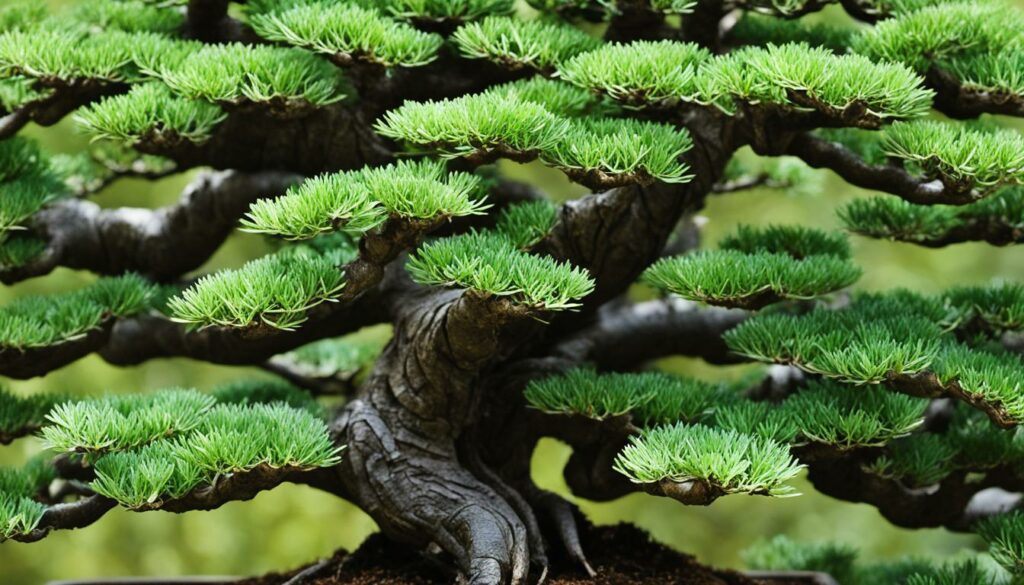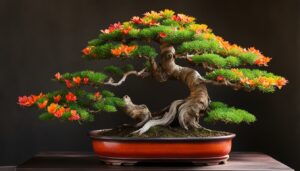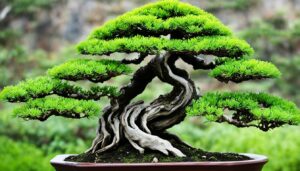If you’re interested in the art of bonsai, you already know that it’s a delicate, intricate craft that requires patience, skill, and attention to detail. One of the essential components of successful bonsai styling is branch positioning and shaping. By manipulating the branches of your tree with care and precision, you can create a beautiful, balanced, and visually striking bonsai.
In this article, we will explore the principles and techniques of bonsai styling branch positioning and shaping. Whether you’re a beginner or an experienced bonsai enthusiast, you’ll discover valuable tips and insights that will help you take your bonsai to the next level.
Key Takeaways
- Bonsai styling requires careful branch positioning and shaping to create a beautiful and balanced tree.
- Choosing the right branches and understanding bonsai aesthetics is essential for successful branch positioning and shaping.
- Various techniques like wiring, pruning, and thinning can help manipulate branches into the desired shape.
- Branch ramification and placement can enhance your bonsai’s visual appeal and create a sense of movement.
- Bonsai styling requires patience, continual refinement, and an eye for proportional balance.
Understanding Bonsai Aesthetics
Before you begin the process of branch positioning and shaping, it’s important to grasp the principles of bonsai aesthetics. The overall visual appeal of a bonsai is heavily influenced by tree balance, or the distribution of branches throughout the tree. A well-balanced bonsai tree creates a sense of harmony and tranquility, while an unbalanced tree can appear jarring to the eye.
Tree balance refers to both the physical and visual weight of a tree’s branches. A tree with heavier branches on one side will appear unbalanced, while one with evenly distributed weight will appear balanced. In addition, the placement of branches can create visual movement within a tree, adding to its overall aesthetic appeal.
To achieve optimal tree balance in your bonsai, consider the placement and density of branches throughout the tree. For example, a bonsai with too many branches on one side can create a sense of imbalance, while evenly spaced branches on all sides will create a sense of stability and harmony.
To further illustrate the importance of tree balance, take a look at the image below:
“The harmony and symmetry of a bonsai tree often capture their owners’ hearts and provide a sense of peace and tranquility. Achieving this level of balance can take years of training and practice, but the end result is a stunning work of art.”
Selecting the Right Branches
When it comes to bonsai styling, selecting the right branches is essential. There are several crucial factors to consider when choosing branches for positioning and shaping purposes, including size, angle, and overall health.
The size of the branch plays a significant role in determining its suitability for positioning and shaping. You should choose branches that are neither too thick nor too thin, as either of these extremes can be challenging to work with. A branch that is too thick will require more extensive wiring and manipulation, while a branch that is too thin will be more delicate and prone to damage.
The angle of the branch is also a critical factor to consider. Choosing branches with the right angle can help enhance the overall aesthetics of your bonsai. For example, branches that are positioned upward can help create a sense of upward growth and vitality, while downward sloping branches can create a more relaxed and tranquil appearance.
Finally, it’s important to consider the health of the branch when selecting it for positioning and shaping. Healthy branches will be stronger and more resilient, making them easier to manipulate without risking damage to the tree.
Remember that selecting the right branches is just the first step in the bonsai styling process. Once you have chosen your branches, you’ll need to use various techniques, such as wiring and pruning, to shape and position them correctly.
Branch Positioning Techniques
Branch positioning techniques are essential for creating the desired shape and balance in bonsai trees while promoting healthy growth. One of the most common techniques is wiring, which involves wrapping a copper or aluminum wire around the trunk or branches and bending them into the desired position. Copper wire is preferred for its flexibility and ability to hold its shape over time. To use this technique effectively, select a wire that is 1/3 the thickness of the branch you want to bend and wrap it around the trunk or branch at a 45-degree angle. Then gently bend the branch into the desired position, making sure not to break or damage it.
Another technique for branch positioning is called guy wiring. This method involves using a wire or string tied to the trunk of the bonsai tree and attached to the branch, pulling it down into the desired position. This technique is particularly useful for heavy or thick branches that are difficult to bend with conventional wiring.
When wiring or using guy wires, remember to check the wiring regularly to ensure it is not cutting into the bark or damaging the branch. Remove the wiring once the branch has set into the desired position to prevent scarring.
Benefits of Branch Positioning Techniques
Effective branch positioning creates a harmonious and visually appealing bonsai tree while promoting healthy growth. With proper techniques, bonsai enthusiasts can create a wide range of shapes and styles, from formal upright to cascading and everything in between. By mastering branch positioning techniques such as wiring and guy wiring, you can bring your artistic vision to life and create beautiful, natural-looking bonsai trees.
Basic Branch Structure
The basic structure of a bonsai tree relies heavily on the positioning and shaping of the primary branches. These primary branches act as the foundation for the rest of the tree, and their placement is critical in establishing the overall shape and form. Properly positioning these branches requires an understanding of the tree’s natural growth pattern and how to manipulate it.
When selecting primary branches, look for those that are relatively thick and sturdy, as they provide the strength and stability needed to support the smaller and more delicate secondary branches. Primary branches typically emerge from the trunk at an upward angle, creating a V-shape that helps to balance the tree’s overall structure.
Once you have chosen the primary branches, it is important to position them in a way that creates a sense of balance and harmony. This involves manipulating their angle and direction, using wiring and pruning techniques to achieve the desired shape and form. Take care not to position the branches in a way that interferes with the overall aesthetics of the tree or compromises its health.
Primary Branch Positioning Tips:
- Choose sturdy, thick branches as primary branches;
- Position primary branches in a V-shape formation;
- Use wiring and pruning techniques to achieve desired angle and direction;
- Ensure that primary branch positioning supports the overall aesthetics and health of the tree.
By mastering the basics of bonsai branch structure and primary branch positioning, you can create a strong foundation for your tree’s future growth and development. With time, patience, and a keen eye for aesthetics, your bonsai will flourish into a beautiful and captivating work of art.
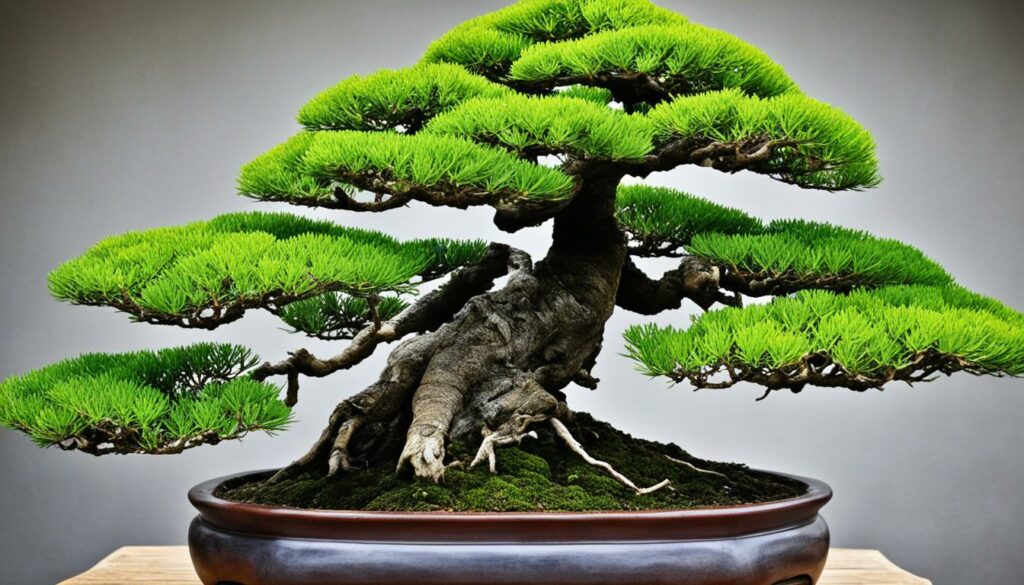
Enhancing Branch Ramification
The art of bonsai lies not just in shaping and positioning the branches, but also in creating refined and intricate branch structures. This is where enhancing branch ramification comes into play. Branch ramification refers to the development of secondary branches that create a more natural, tree-like appearance. By promoting the growth of secondary branches, you can enhance the overall aesthetics and balance of your bonsai tree.
One technique for enhancing branch ramification is through pruning. Pruning involves selectively removing branches to encourage the growth of new buds and side shoots. By pruning back the tips of branches, you can stimulate the growth of secondary branches, resulting in a fuller and more natural-looking tree.
Another technique is using specialized wiring to encourage the growth of secondary branches. By wrapping wire around a primary branch and bending it to a downward angle, you can create a sharp angle where the branch will start to divide. Over time, this will encourage new side shoots to emerge from the primary branch, resulting in a more intricate and refined branch structure.
It is important to note that you should only wire branches when they are young and pliable. Otherwise, you run the risk of damaging the tree or creating unnatural-looking shapes. Patience is key when enhancing branch ramification, as it can take several growing seasons for the secondary branches to fully develop.
Expert Tip: When promoting the growth of secondary branches, it is important to maintain a proportional balance between the primary and secondary branches. Be sure to evaluate the overall aesthetics and balance of your tree as you work on enhancing the branch ramification.
Branch Pruning and Thinning
Pruning and thinning are crucial techniques for maintaining the aesthetics and balance of your bonsai tree. By selectively removing excess branches and foliage, you can refine the shape and structure while promoting healthy growth.
Branch pruning involves removing unwanted or unnecessary branches from the tree. This technique ensures that the remaining branches have enough space and resources to grow and develop properly. When pruning branches, make sure to use clean, sharp tools to avoid damaging the tree.
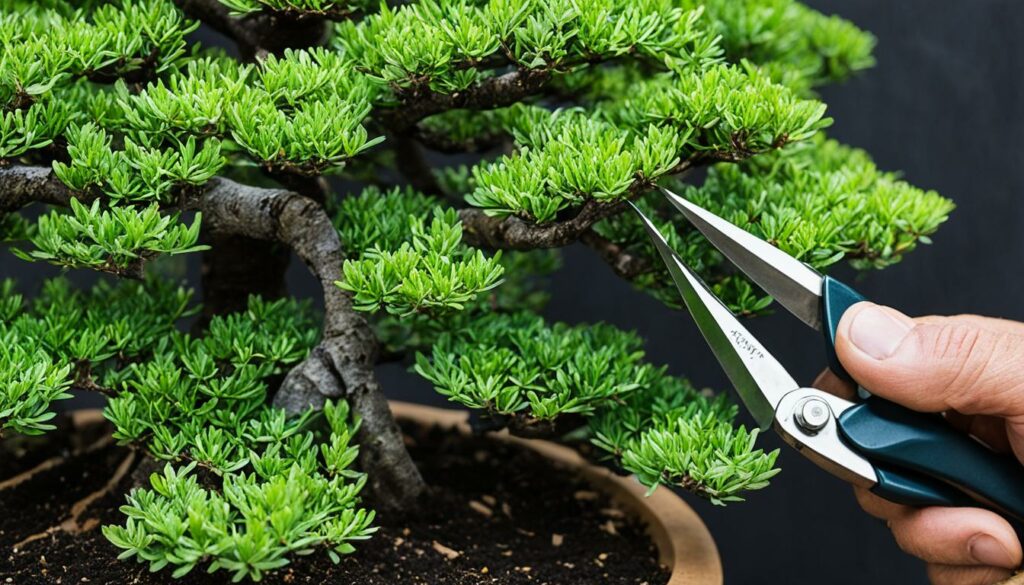
Branch Thinning
Branch thinning involves selectively removing foliage from the branches to improve the overall structure and balance of the tree. This technique allows more light and air to reach the remaining leaves, promoting healthy growth and preventing disease.
When thinning branches, make sure to remove only a small portion of the foliage at a time to avoid damaging the tree. It’s also important to thin branches in a way that maintains the overall shape and balance of the tree.
“Proper pruning and thinning techniques are essential for achieving the ideal shape and structure of your bonsai tree. With patience and careful attention to detail, you can create a stunning and harmonious work of art.”
| Branch Pruning | Branch Thinning |
|---|---|
| Removes unwanted or unnecessary branches | Removes excess foliage from branches |
| Promotes healthy growth of remaining branches | Allows more light and air to reach remaining leaves |
| Use clean, sharp tools to avoid damage to the tree | Remove only a small portion of foliage at a time |
Branch Placement for Visual Interest
Proper branch placements can enhance the overall aesthetic appeal of your bonsai tree and make it more visually interesting. Instead of arranging branches in a predictable pattern, you can explore creative techniques to achieve a unique look.
One technique is cross-branching, where branches from different directions are intersected to create an unusual and visually captivating effect. Another technique is layering, where branches are positioned in different planes to give the appearance of depth. Additionally, the use of negative space can create visual interest by emphasizing the empty spaces between branches.
When positioning branches, it is crucial to consider the overall composition of your bonsai tree. Aim for balance and harmony by ensuring that the branches are distributed evenly and complement each other. Experiment with different arrangements and techniques to find the one that best suits your artistic vision.
Creating Movement through Branch Positioning
When it comes to creating dynamic styling in your bonsai, branch positioning is key. By guiding branch growth in specific directions, you can create a sense of fluidity and flow, giving your tree a more natural and dynamic appearance. Here are some techniques to achieve branch movement in your bonsai:
- Curving branches: By bending branches slightly, you can create the appearance of a gentle breeze blowing through the tree.
- Slanting branches: Tilting branches to the side can create the appearance of a tree that has been shaped by the elements, such as wind or snow.
- Tilting branches: Tipping branches up or down can create the impression of movement, as if the tree is reaching for the light or leaning away from the wind.
By combining these techniques with careful branch placement and proportional balance, you can create a stunning bonsai tree that captures the eye and imagination. Check out the image below for an example of how dynamic styling can transform a bonsai tree.
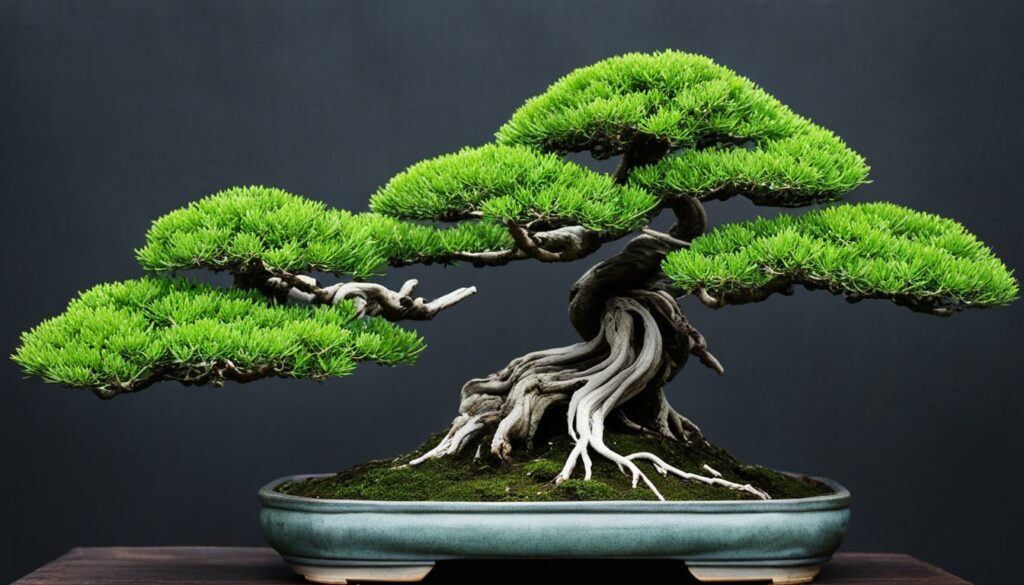
Remember to take your time when working on your bonsai tree. Creating movement through branch positioning requires patience and careful attention to detail, but the results are well worth the effort.
Branch Arrangement for Bonsai Styles
Each bonsai style has unique branch arrangements that capture the essence of the tree’s natural form. By understanding the fundamental principles of each style, you can shape and position the branches in harmony with nature. Let’s explore the techniques used to achieve branch arrangements for popular bonsai styles.
Formal Upright Style
One of the most traditional bonsai styles is the Formal Upright style. This style emulates the natural growth of trees in an upright position, with a defined apex, symmetrical branches, and a tapered trunk. Positioning the primary branches at equidistant intervals creates a sense of balance and unity in the tree.
Slanting Style
The Slanting Style is characterized by the trunk and branches inclined at an angle. The tree gives the impression of being shaped by natural forces such as wind, weather, or avalanches. The primary branches are positioned and tapered to create a more naturalistic appearance.
Cascade Style
The Cascade Style is similar to the Slanting style but has a longer, more vertical trunk line extending downward. The branches appear to hang down from the trunk like a waterfall, evoking a feeling of movement and serenity. The primary branch, now called a “knob,” is placed at the cascading point; thereafter, the branches grow downwards and outwards.
Windswept Style
The Windswept Style replicates the appearance of trees shaped and contorted by strong winds. The branches appear to be blown to one side, with all branches angled in the same direction. The primary branch is placed on the side that faces the prevailing wind.
By understanding and mastering the branch positioning techniques associated with each style, you can create stunning bonsai trees that showcase the beauty of nature.
Balancing Branch Density and Proportions
Creating a visually harmonious bonsai tree requires achieving the right balance of branch density and proportions. When evaluating your tree’s branch density, consider the following:
- Are there too many branches in one area and not enough in another?
- Are branches crossing each other and creating a cluttered appearance?
To balance the branch density, selective pruning and thinning can aid in achieving a more proportional structure. This will allow light to penetrate into the lower branches and promote healthy growth throughout the tree.
Proportional balance is also important when positioning branches. Consider the overall height and width of the tree when determining the size and placement of individual branches. For example, larger and heavier branches should be placed lower on the tree for stability and balance.
Manipulation of the branch angle and direction can also contribute to proportional balance. For instance, branches that are angled upwards can create a sense of upward growth and dominance, while horizontal branches can provide a sense of stability.
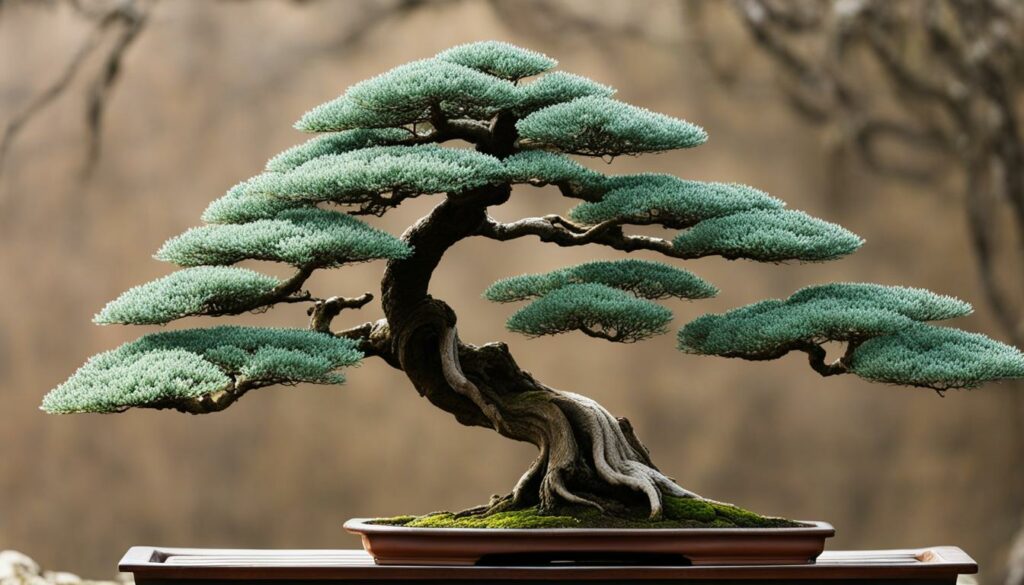
As you assess and adjust the branch density and proportions of your bonsai, always keep in mind the overall aesthetic you wish to achieve. By taking the time to evaluate and fine-tune these aspects of your tree, you can achieve a visually stunning and well-balanced bonsai that reflects your skill and artistry.
Shaping Techniques for Branches
When it comes to bonsai styling, creating the desired shape and form of the branches is essential to achieve a visually appealing composition. There are several shaping techniques you can employ, such as:
- Pruning: removing excess branches and foliage to enhance the overall structure and balance of your bonsai.
- Wiring: manipulating the branches into the desired position by wrapping them with wire, allowing you to create intricate bends and curves.
- Bending: using gentle pressure to shape the branches into the desired form, often accomplished with specialized bonsai tools.
Each technique can help you refine your bonsai trees. However, it’s essential to approach this process with caution and expertise to prevent damaging the branches or hindering the tree’s growth. Experimentation and patience are key, and you’ll likely need some practice to master each technique fully.
To maintain the health and vitality of your tree while using these techniques, it’s vital to ensure you’re not removing too much foliage or putting undue stress on the branches. If done correctly, shaping techniques can help you achieve the right balance and proportions of your branches while retaining the natural appearance of the tree.
Ultimately, shaping techniques play an essential role in bonsai styling branch positioning and shaping. With the right knowledge and tools, you can create stunning bonsai trees that reflect your artistic vision and passion for the art of bonsai.
Patience and Continual Refinement
Congratulations! You now have the knowledge and skills to create a beautiful bonsai tree through proper branch positioning and shaping. As you embark on this journey, remember that this art form requires patience and continual refinement.
Bonsai trees take years to mature, and their branches require constant attention to maintain the desired shape. Be patient in your journey and continue to refine your skills with each new tree.
As your bonsai matures, you may need to reassess and adjust its branch positioning. This is normal and necessary for maintaining the tree’s aesthetics and health. Take the time to evaluate and refine your tree’s branch structure, and you will be rewarded with a stunning work of art.
Remember, bonsai styling branch positioning and shaping is not a one-time process; it is a continuous journey of refinement. Embrace the art, be patient with the process, and continue to improve your skills to create a masterpiece that you can proudly display for years to come.
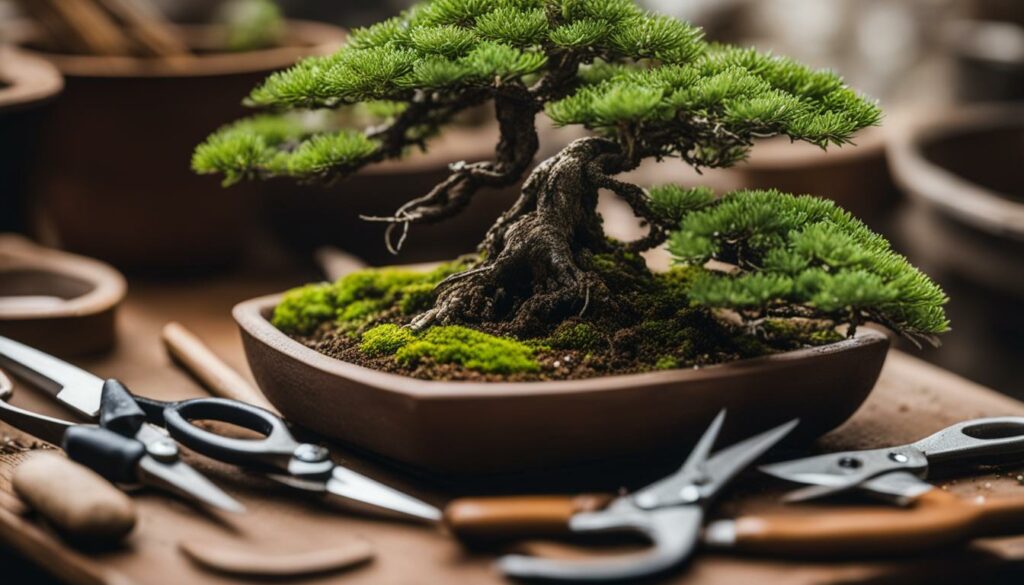
Tools for Branch Positioning and Shaping
In addition to a keen eye and a steady hand, precise bonsai styling requires the right tools. Explore the common tools used for branch positioning and shaping in bonsai.
Wire Cutters
One of the essential tools for branch positioning in bonsai is wire cutters. These specialized cutters can accurately cut aluminum or copper wire used to wrap around tree branches to gently manipulate them into the desired shape.
Bonsai Scissors
Bonsai scissors are useful for selectively pruning branches, leaves, and roots to maintain the tree’s health and enhance its aesthetics. These scissors come in different sizes, with longer blades for heavier cutting and shorter blades for precision trimming.
Concave Cutters
Concave cutters are designed to make clean, concave cuts for removing small branches without damaging the remaining bark. These cutters allow the tree to heal more quickly, reducing the likelihood of infection.
Branch Benders
Branch benders are specialized tools used to gently bend branches into the desired position without breaking them. These tools come in different sizes and shapes to accommodate branches of various thicknesses.
Tip: Always sterilize your bonsai tools before and after use to prevent the spread of diseases.
Bonsai Pliers
Bonsai pliers can be used for various tasks, such as removing wire, shaping jin and shari (deadwood), and adjusting the position of the tree. They come in different shapes and sizes and can be helpful for reaching tight areas.
Bonsai Knob Cutters
Bonsai knob cutters can be used to create jin and shari. The rounded blades can make concave cuts, leaving a small, circular scar that heals more quickly than a flat cut. These cutters can also be used to remove small branches or prune roots.
Bonsai Root Hooks
Bonsai root hooks are essential for repotting and maintaining the health of your bonsai. Use these hooks to carefully comb and trim the roots, removing any damaged or unwanted roots while preserving the healthy ones.
Ensure you have the right tools for maintaining the health and aesthetics of your bonsai. With precise branch positioning and shaping techniques and the right tools, you can cultivate beautiful and enduring bonsai trees.
Conclusion
Congratulations on completing this comprehensive guide to bonsai styling, branch positioning, and shaping. By mastering these techniques and principles, you can create stunning bonsai trees that reflect your artistic vision and passion for the art of bonsai.
Remember, bonsai styling is an ongoing process that requires patience, practice, and attention to detail. Through continual refinement and evaluation, you can achieve beautiful, harmonious trees that captivate and inspire.
Whether you are a seasoned bonsai enthusiast or a beginner, this guide has provided you with the knowledge and tools necessary to create beautiful and healthy bonsai trees. From understanding bonsai aesthetics to selecting the right branches and using proper positioning and shaping techniques, you now have the foundation to create unique and breathtaking bonsai designs.
So go forth and experiment with different styles, shapes, and techniques. With dedication and perseverance, you can take your bonsai styling, branch positioning, and shaping skills to the next level and create stunning works of living art.
FAQ
What is bonsai styling branch positioning and shaping?
Bonsai styling branch positioning and shaping refers to the techniques used to arrange and shape the branches of a bonsai tree to create a harmonious and aesthetically pleasing appearance. It involves selecting the right branches, manipulating their position and shape, and pruning and thinning to achieve the desired visual balance.
Why is understanding bonsai aesthetics important?
Understanding bonsai aesthetics is essential because it helps to create visually appealing bonsai trees. Aesthetics encompass factors such as tree balance, branch placement, and overall composition, contributing to the overall beauty and appeal of a bonsai. By understanding these principles, you can create bonsai that captivate and inspire.
How do I select the right branches for bonsai styling?
When selecting branches for bonsai styling, consider their size, angle, and overall health. Look for branches that are proportionate to the size of the bonsai and have a suitable angle for the desired style. Additionally, choose branches that are healthy and free from diseases or damage.
What techniques can be used for branch positioning?
Branch positioning techniques include wiring, which involves wrapping wire around branches to hold them in a desired position, and bending, which relies on carefully applying pressure to branches to change their shape. These techniques allow you to manipulate the branches and create the desired branch arrangement.
What is the significance of primary branches in bonsai?
Primary branches are the foundational branches that establish the overall framework of a bonsai tree. They provide the structure and shape to the tree’s design. Properly positioning and shaping these primary branches are crucial for creating a well-balanced and visually appealing bonsai.
How can I enhance branch ramification in my bonsai?
Branch ramification refers to the intricate branching pattern of a bonsai tree. To enhance branch ramification, you can encourage the growth of secondary branches through techniques such as selective pruning and proper fertilization. This will create a more natural and intricate branch structure.
Why is branch pruning and thinning important in bonsai styling?
Branch pruning and thinning are important in bonsai styling as they help to maintain the aesthetics and balance of the tree. Pruning involves selectively removing branches to enhance the overall shape and form of the bonsai, while thinning involves removing excess foliage to improve airflow and light penetration.
How can I position branches strategically to create visual interest in my bonsai?
Positioning branches strategically can create visual interest in your bonsai. Techniques such as cross-branching, where branches intersect each other, layering, where branches are arranged in distinct layers, and the use of negative space can all contribute to an engaging and visually appealing composition.
How can I create movement in my bonsai through branch positioning?
To create a sense of movement in your bonsai, you can curve, slant, or tilt branches. By positioning branches in fluid and dynamic ways, you can create a more visually engaging tree that conveys a sense of motion and vitality.
How does branch placement vary for different bonsai styles?
Different bonsai styles have specific branch arrangements. For example, formal upright bonsai requires a straight and upward-reaching trunk with evenly spaced branches, while cascade bonsai features branches that cascade downwards. Understanding the branch positioning and shaping techniques associated with each style is crucial for achieving the desired aesthetic.
How do I balance the branch density and proportions in my bonsai?
Achieving the right balance of branch density and proportions is essential for creating a visually pleasing bonsai. Regular assessment and adjustment of the density and proportions of branches through pruning and thinning techniques will help to maintain the aesthetic harmony of the tree.
What are the shaping techniques used for branches in bonsai styling?
Shaping techniques for branches in bonsai styling include pruning, which involves cutting back branches to achieve the desired shape, wiring, which allows you to bend and position branches, and bending, where pressure is applied to branches to change their direction or shape. These techniques enable you to sculpt the branches and create the desired form for your bonsai.
Why is patience and continual refinement important in bonsai styling?
Bonsai styling is a process that requires patience and continual refinement. Trees take time to mature and develop their desired form. Regular assessment and adjustment of branch positioning as the tree grows and changes will help you achieve the desired result and create a bonsai that reflects your artistic vision.
What tools are commonly used for branch positioning and shaping in bonsai?
Common tools for branch positioning and shaping in bonsai include wire cutters, which are used to cut and remove wire used for branch manipulation, and branch benders, which allow you to exert controlled pressure to bend branches. These tools aid in achieving precise and controlled branch positioning.
